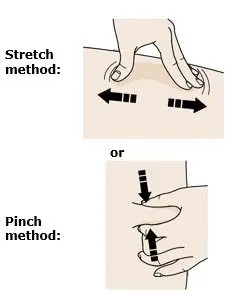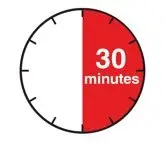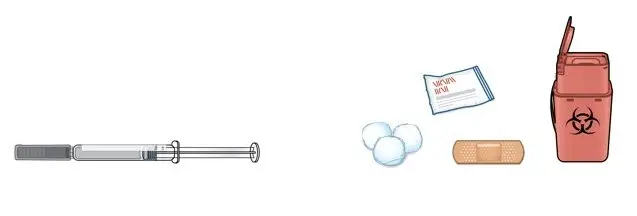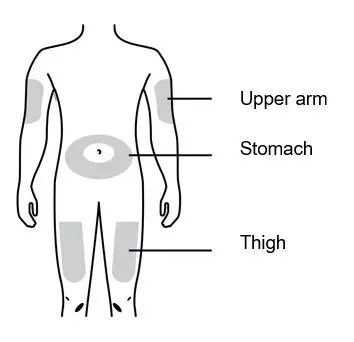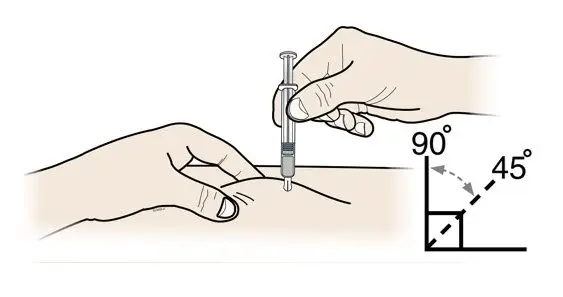Drug Detail:Repatha (Evolocumab [ e-voe-lok-ue-mab ])
Drug Class: PCSK9 inhibitors
Highlights of Prescribing Information
REPATHA (evolocumab) injection, for subcutaneous use
Initial U.S. Approval: 2015
Recent Major Changes
| Indications and Usage (1) | 09/2021 |
| Dosage and Administration (2.1) | 09/2021 |
| Dosage and Administration (2.3) | 02/2021 |
| Contraindications (4) | 02/2021 |
| Warnings and Precautions (5.1) | 02/2021 |
Indications and Usage for Repatha
REPATHA is a PCSK9 (proprotein convertase subtilisin kexin type 9) inhibitor indicated:
- in adults with established cardiovascular disease (CVD) to reduce the risk of myocardial infarction, stroke, and coronary revascularization (1)
- as an adjunct to diet, alone or in combination with other low-density lipoprotein cholesterol (LDL-C)-lowering therapies, in adults with primary hyperlipidemia, including heterozygous familial hypercholesterolemia (HeFH), to reduce LDL-C (1)
- as an adjunct to diet and other LDL-C-lowering therapies in pediatric patients aged 10 years and older with HeFH, to reduce LDL-C (1)
- as an adjunct to other LDL-C-lowering therapies in adults and pediatric patients aged 10 years and older with homozygous familial hypercholesterolemia (HoFH), to reduce LDL-C (1)
Repatha Dosage and Administration
In adults with established CVD or with primary hyperlipidemia:
- The recommended dosage of REPATHA is either 140 mg every 2 weeks OR 420 mg once monthly administered subcutaneously. (2.1)
- If switching dosage regimens, administer the first dose of the new regimen on the next scheduled date of the prior regimen. (2.1)
In pediatric patients aged 10 years and older with HeFH:
- The recommended dosage of REPATHA is either 140 mg every 2 weeks OR 420 mg once monthly administered subcutaneously. (2.1)
- If switching dosage regimens, administer the first dose of the new regimen on the next scheduled date of the prior regimen. (2.1)
In adults and pediatric patients aged 10 years and older with HoFH:
- The initial recommended dosage of REPATHA is 420 mg once monthly administered subcutaneously. (2.1)
- The dosage can be increased to 420 mg every 2 weeks if a clinically meaningful response is not achieved in 12 weeks. (2.1)
- Patients on lipid apheresis may initiate treatment with 420 mg every 2 weeks to correspond with their apheresis schedule. Administer REPATHA after the apheresis session is complete. (2.1)
- Assess LDL-C when clinically appropriate. The LDL-lowering effect of REPATHA may be measured as early as 4 weeks after initiation. (2.1)
- Advise latex-sensitive patients that the needle cover of the glass single-dose prefilled syringe and the single-dose prefilled autoinjector contain dry natural rubber, a derivative of latex. (2.3)
- Administer REPATHA subcutaneously into areas of the abdomen, thigh, or upper arm. Rotate injection sites for each administration. (2.3)
- See Full Prescribing Information for important administration instructions. (2.3)
Dosage Forms and Strengths
- Injection: 140 mg/mL solution single-dose prefilled syringe (3)
- Injection: 140 mg/mL solution single-dose prefilled SureClick® autoinjector (3)
- Injection: 420 mg/3.5 mL solution single-dose Pushtronex® system (on-body infusor with prefilled cartridge) (3)
Contraindications
Patients with a history of a serious hypersensitivity reaction to evolocumab or any of the excipients in REPATHA. (4)
Warnings and Precautions
Hypersensitivity Reactions: Angioedema has occurred. If signs or symptoms of serious hypersensitivity reactions occur, discontinue treatment with REPATHA, treat according to the standard of care, and monitor until signs and symptoms resolve. (5.1)
Adverse Reactions/Side Effects
Common (> 5% of patients treated with REPATHA and more frequently than placebo) adverse reactions in adults with:
Primary hyperlipidemia: nasopharyngitis, upper respiratory tract infection, influenza, back pain, and injection site reactions. (6)
Established CVD: diabetes mellitus, nasopharyngitis and upper respiratory tract infection. (6)
To report SUSPECTED ADVERSE REACTIONS, contact Amgen Medical Information at 1-800-77-AMGEN (1-800-772-6436) or FDA at 1-800-FDA-1088 or www.fda.gov/medwatch.
See 17 for PATIENT COUNSELING INFORMATION and FDA-approved patient labeling.
Revised: 9/2021
Full Prescribing Information
1. Indications and Usage for Repatha
REPATHA is indicated:
- In adults with established cardiovascular disease to reduce the risk of myocardial infarction, stroke, and coronary revascularization
- As an adjunct to diet, alone or in combination with other low-density lipoprotein cholesterol (LDL-C)-lowering therapies, in adults with primary hyperlipidemia, including heterozygous familial hypercholesterolemia (HeFH), to reduce LDL-C
- As an adjunct to diet and other LDL-C-lowering therapies in pediatric patients aged 10 years and older with HeFH, to reduce LDL-C
- As an adjunct to other LDL-C-lowering therapies in adults and pediatric patients aged 10 years and older with homozygous familial hypercholesterolemia (HoFH), to reduce LDL-C
2. Repatha Dosage and Administration
2.1 Recommended Dosage
- In adults with established cardiovascular disease or with primary hyperlipidemia:
- The recommended dosage of REPATHA is either 140 mg every 2 weeks OR 420 mg once monthly administered subcutaneously [see Dosage and Administration (2.3)].
- If switching dosage regimens, administer the first dose of the new regimen on the next scheduled date of the prior regimen.
-
In pediatric patients aged 10 years and older with HeFH:
- The recommended dosage of REPATHA is either 140 mg every 2 weeks OR 420 mg once monthly administered subcutaneously [see Dosage and Administration (2.3)].
- If switching dosage regimens, administer the first dose of the new regimen on the next scheduled date of the prior regimen.
-
In adults and pediatric patients aged 10 years and older with HoFH:
- The initial recommended dosage of REPATHA is 420 mg once monthly administered subcutaneously [see Dosage and Administration (2.3)].
- The dosage can be increased to 420 mg every 2 weeks if a clinically meaningful response is not achieved in 12 weeks.
- Patients on lipid apheresis may initiate treatment with 420 mg every 2 weeks to correspond with their apheresis schedule. Administer REPATHA after the apheresis session is complete.
- Assess LDL-C when clinically appropriate. The LDL-lowering effect of REPATHA may be measured as early as 4 weeks after initiation.
- When monitoring LDL-C for patients receiving REPATHA 420 mg once monthly, note that LDL-C can vary during the dosing interval in some patients; recommend measuring LDL-C just prior to the next scheduled dose [see Clinical Studies (14)].
2.2 Missed Doses
If a dose is missed:
- Within 7 days from the missed dose, instruct the patient to administer REPATHA and resume the patient's original schedule.
- More than 7 days after the missed dose:
- For an every 2-week dose, instruct the patient to wait until the next dose on the original schedule.
- For a once-monthly dose, instruct the patient to administer the dose and start a new schedule based on this date.
2.3 Important Administration Instructions
- Advise latex-sensitive patients that the needle cover of the glass single-dose prefilled syringe and the single-dose prefilled autoinjector contain dry natural rubber (a derivative of latex) that may cause allergic reactions in individuals sensitive to latex [see Warnings and Precautions (5.1)].
- Train patients and/or caregivers on how to prepare and administer REPATHA, according to the Instructions for Use and instruct them to read and follow the Instructions for Use each time they use REPATHA.
- Prior to use, allow REPATHA to warm to room temperature for at least 30 minutes for the prefilled autoinjector or syringe and for at least 45 minutes for the on-body infusor with prefilled cartridge if REPATHA has been refrigerated [see How Supplied/Storage and Handling (16)].
- Visually inspect REPATHA prior to administration. REPATHA is a clear to opalescent, colorless to pale yellow solution. Do not use if the solution is cloudy, discolored, or contains particles.
- Administer REPATHA subcutaneously into areas of the abdomen, thigh, or upper arm that are not tender, bruised, red, or indurated. Avoid injecting into areas with scars or stretch marks. Rotate injection sites for each administration.
-
The 420 mg dose of REPATHA can be administered:
- over 5 minutes by using the single-dose on-body infusor with prefilled cartridge, or
- by giving 3 injections consecutively within 30 minutes using the single-dose prefilled autoinjector or single-dose prefilled syringe.
3. Dosage Forms and Strengths
REPATHA is a clear to opalescent, colorless to pale yellow solution available as follows:
- Injection: 140 mg/mL solution in a single-dose prefilled syringe
- Injection: 140 mg/mL solution in a single-dose prefilled SureClick® autoinjector
- Injection: 420 mg/3.5 mL solution in a single-dose Pushtronex® system (on-body infusor with prefilled cartridge)
4. Contraindications
REPATHA is contraindicated in patients with a history of a serious hypersensitivity reaction to evolocumab or any of the excipients in REPATHA. Serious hypersensitivity reactions including angioedema have occurred in patients treated with REPATHA [see Warnings and Precautions (5.1)].
5. Warnings and Precautions
5.1 Hypersensitivity Reactions
Hypersensitivity reactions, including angioedema, have been reported in patients treated with REPATHA. If signs or symptoms of serious hypersensitivity reactions occur, discontinue treatment with REPATHA, treat according to the standard of care, and monitor until signs and symptoms resolve. REPATHA is contraindicated in patients with a history of serious hypersensitivity reactions to evolocumab or any excipient in REPATHA [see Contraindications (4)].
The needle cover of the glass single-dose prefilled syringe and the single-dose prefilled autoinjector contain dry natural rubber (a derivative of latex) which may cause an allergic reaction in individuals sensitive to latex.
6. Adverse Reactions/Side Effects
The following adverse reactions are also discussed in other sections of the label:
- Hypersensitivity Reactions [see Warnings and Precautions (5.1)]
6.1 Clinical Trials Experience
Because clinical trials are conducted under widely varying conditions, adverse reaction rates observed in the clinical trials of a drug cannot be directly compared to rates in the clinical trials of another drug and may not reflect the rates observed in clinical practice.
Adverse Reactions in Adults with Primary Hyperlipidemia
The data described below reflect exposure to REPATHA in 8 placebo-controlled trials that included 2651 patients treated with REPATHA, including 557 exposed for 6 months and 515 exposed for 1 year (median treatment duration of 12 weeks). The mean age of the population was 57 years, 49% of the population were women, 85% White, 6% Black, 8% Asians, and 2% other races.
Adverse Reactions in a 52-Week Controlled Trial
In a 52-week, double-blind, randomized, placebo-controlled trial, 599 patients received 420 mg of REPATHA subcutaneously once monthly [see Clinical Studies (14)]. The mean age was 56 years (range: 22 to 75 years), 23% were older than 65 years, 52% women, 80% White, 8% Black, 6% Asian; 6% identified as Hispanic ethnicity. Adverse reactions reported in at least 3% of REPATHA-treated patients, and more frequently than in placebo-treated patients are shown in Table 1. Adverse reactions led to discontinuation of treatment in 2.2% of REPATHA-treated patients and 1% of placebo-treated patients. The most common adverse reaction that led to REPATHA treatment discontinuation and occurred at a rate greater than placebo was myalgia (0.3% versus 0% for REPATHA and placebo, respectively).
| Placebo (N = 302) % | REPATHA (N = 599) % |
|
|---|---|---|
|
||
| Nasopharyngitis | 9.6 | 10.5 |
| Upper respiratory tract infection | 6.3 | 9.3 |
| Influenza | 6.3 | 7.5 |
| Back pain | 5.6 | 6.2 |
| Injection site reactions* | 5.0 | 5.7 |
| Cough | 3.6 | 4.5 |
| Urinary tract infection | 3.6 | 4.5 |
| Sinusitis | 3.0 | 4.2 |
| Headache | 3.6 | 4.0 |
| Myalgia | 3.0 | 4.0 |
| Dizziness | 2.6 | 3.7 |
| Musculoskeletal pain | 3.0 | 3.3 |
| Hypertension | 2.3 | 3.2 |
| Diarrhea | 2.6 | 3.0 |
| Gastroenteritis | 2.0 | 3.0 |
Adverse Reactions in Seven Pooled 12-Week Controlled Trials
In seven pooled 12-week, double-blind, randomized, placebo-controlled trials, 993 patients received 140 mg of REPATHA subcutaneously every 2 weeks and 1059 patients received 420 mg of REPATHA subcutaneously monthly. The mean age was 57 years (range: 18 to 80 years), 29% were older than 65 years, 49% women, 85% White, 5% Black, 9% Asian; 5% identified as Hispanic ethnicity. Adverse reactions reported in at least 1% of REPATHA-treated patients, and more frequently than in placebo-treated patients, are shown in Table 2.
| Placebo (N = 1224) % | REPATHA*
(N = 2052) % |
|
|---|---|---|
|
||
| Nasopharyngitis | 3.9 | 4.0 |
| Back pain | 2.2 | 2.3 |
| Upper respiratory tract infection | 2.0 | 2.1 |
| Arthralgia | 1.6 | 1.8 |
| Nausea | 1.2 | 1.8 |
| Fatigue | 1.0 | 1.6 |
| Muscle spasms | 1.2 | 1.3 |
| Urinary tract infection | 1.2 | 1.3 |
| Cough | 0.7 | 1.2 |
| Influenza | 1.1 | 1.2 |
| Contusion | 0.5 | 1.0 |
6.2 Immunogenicity
As with all therapeutic proteins, there is potential for immunogenicity. The detection of antibody formation is highly dependent on the sensitivity and specificity of the assay. Additionally, the observed incidence of antibody (including neutralizing antibody) positivity in an assay may be influenced by several factors including assay methodology, sample handling, timing of sample collection, concomitant medications, and underlying disease. For these reasons, comparison of the incidence of antibodies to REPATHA in the studies described below with the incidence of antibodies in other studies or to other products may be misleading.
The immunogenicity of REPATHA has been evaluated using an electrochemiluminescent bridging screening immunoassay for the detection of binding anti-drug antibodies. For patients whose sera tested positive in the screening immunoassay, an in vitro biological assay was performed to detect neutralizing antibodies.
In a pool of placebo- and active-controlled clinical trials, 0.3% (48 out of 17,992) of adult patients treated with at least one dose of REPATHA tested positive for the development of binding antibodies. Patients whose sera tested positive for binding antibodies were further evaluated for neutralizing antibodies; none of the patients tested positive for neutralizing antibodies.
The development of anti-evolocumab antibodies was not detected in clinical trials of pediatric patients treated with REPATHA.
There was no evidence that the presence of anti-drug binding antibodies impacted the pharmacokinetic profile, clinical response, or safety of REPATHA.
6.3 Postmarketing Experience
The following additional adverse reactions have been identified during post-approval use of REPATHA. Because these reactions are reported voluntarily from a population of uncertain size, it is not always possible to reliably estimate their frequency or establish a causal relationship to drug exposure.
- Hypersensitivity reactions: Angioedema
- Influenza-like illness
8. Use In Specific Populations
8.4 Pediatric Use
The safety and effectiveness of REPATHA in combination with diet and other LDL-C-lowering therapies for the treatment of HoFH have been established in pediatric patients aged 10 years and older. Use of REPATHA for this indication is supported by evidence from an adequate and well-controlled trial in adults and pediatric patients aged 13 years and older with HoFH (including 7 pediatric patients treated with REPATHA) and from open-label studies which included an additional 19 pediatric patients aged 11 years and older with HoFH not previously treated with REPATHA [see Adverse Reactions (6.1) and Clinical Studies (14)].
The safety and effectiveness of REPATHA as an adjunct to diet and other LDL-C-lowering therapies for the treatment of HeFH have been established in pediatric patients aged 10 years and older. Use of REPATHA for this indication is based on data from a 24-week, randomized, placebo-controlled, double-blind trial in pediatric patients with HeFH. In the trial, 104 patients received REPATHA 420 mg subcutaneously once monthly and 53 patients received placebo; 39 patients (25%) were 10 to 11 years of age [see Adverse Reactions (6.1) and Clinical Studies (14)].
The safety and effectiveness of REPATHA have not been established in pediatric patients with HeFH or HoFH who are younger than 10 years old or in pediatric patients with other types of hyperlipidemia.
8.5 Geriatric Use
In controlled trials, 7656 (41%) patients treated with REPATHA were ≥ 65 years old and 1500 (8%) were ≥ 75 years old. No overall differences in safety or effectiveness were observed between these patients and younger patients, and other reported clinical experience has not identified differences in responses between the elderly and younger patients, but greater sensitivity of some older individuals cannot be ruled out.
11. Repatha Description
Evolocumab is a human monoclonal immunoglobulin G2 (IgG2) directed against human proprotein convertase subtilisin kexin type 9 (PCSK9). Evolocumab has an approximate molecular weight (MW) of 144 kDa and is produced in genetically engineered mammalian (Chinese hamster ovary) cells.
REPATHA is a sterile, preservative-free, clear to opalescent, colorless to pale yellow solution for subcutaneous use. Each 1 mL single-dose prefilled syringe and single-dose prefilled SureClick® autoinjector contains 140 mg evolocumab, acetate (1.2 mg), polysorbate 80 (0.1 mg), proline (25 mg) in Water for Injection, USP. Sodium hydroxide may be used to adjust to a pH of 5.0. Each single-dose Pushtronex® system (on-body infusor with prefilled cartridge) delivers a 3.5 mL solution containing 420 mg evolocumab, acetate (4.2 mg), polysorbate 80 (0.35 mg), proline (89 mg) in Water for Injection, USP. Sodium hydroxide may be used to adjust to a pH of 5.0.
12. Repatha - Clinical Pharmacology
12.1 Mechanism of Action
Evolocumab is a human monoclonal IgG2 directed against human proprotein convertase subtilisin kexin type 9 (PCSK9). PCSK9 binds to the low-density lipoprotein receptor (LDLR) on the surface of hepatocytes to promote LDLR degradation within the liver. By inhibiting the binding of PCSK9 to LDLR, evolocumab increases the number of LDLRs available to clear LDL from the blood, thereby lowering LDL-C levels.
12.2 Pharmacodynamics
Following single subcutaneous administration of 140 mg or 420 mg of evolocumab, maximum suppression of circulating unbound PCSK9 occurred by 4 hours. Unbound PCSK9 concentrations returned toward baseline when evolocumab concentrations decreased below the limit of quantitation. Maximum LDL-C reduction occurred by 2 weeks after a single-dose of 140 mg of evolocumab and by 3 weeks after a single-dose of 420 mg of evolocumab.
12.3 Pharmacokinetics
Evolocumab exhibits non-linear kinetics as a result of binding to PCSK9. Administration of the 140 mg dose in healthy volunteers resulted in a Cmax mean of 18.6 μg/mL and AUClast mean of 188 day∙μg/mL. Administration of the 420 mg dose in healthy volunteers resulted in a Cmax mean of 59.0 μg/mL and AUClast mean of 924 day∙μg/mL. Following a single 420 mg intravenous dose, the mean systemic clearance was estimated to be 12 mL/hr. An approximate 2- to 3-fold accumulation was observed in trough serum concentrations (Cmin 7.21) following 140 mg doses administered subcutaneously every 2 weeks or following 420 mg doses administered subcutaneously monthly (Cmin 11.2), and serum trough concentrations approached steady-state by 12 weeks of dosing.
13. Nonclinical Toxicology
13.1 Carcinogenesis, Mutagenesis, Impairment of Fertility
The carcinogenic potential of evolocumab was evaluated in a lifetime study conducted in the hamster at dose levels of 10, 30, and 100 mg/kg administered every 2 weeks. There were no evolocumab-related tumors at the highest dose at systemic exposures up to 38- and 15-fold the recommended human doses of 140 mg every 2 weeks and 420 mg once monthly, respectively, based on plasma AUC. The mutagenic potential of evolocumab has not been evaluated; however, monoclonal antibodies are not expected to alter DNA or chromosomes.
There were no adverse effects on fertility (including estrous cycling, sperm analysis, mating performance, and embryonic development) at the highest dose in a fertility and early embryonic developmental toxicology study in hamsters when evolocumab was subcutaneously administered at 10, 30, and 100 mg/kg every 2 weeks. The highest dose tested corresponds to systemic exposures up to 30- and 12-fold the recommended human doses of 140 mg every 2 weeks and 420 mg once monthly, respectively, based on plasma AUC. In addition, there were no adverse evolocumab-related effects on surrogate markers of fertility (reproductive organ histopathology, menstrual cycling, or sperm parameters) in a 6-month chronic toxicology study in sexually mature monkeys subcutaneously administered evolocumab at 3, 30, and 300 mg/kg once weekly. The highest dose tested corresponds to 744- and 300-fold the recommended human doses of 140 mg every 2 weeks and 420 mg once monthly, respectively, based on plasma AUC.
13.2 Animal Toxicology and/or Pharmacology
During a 3-month toxicology study of 10 and 100 mg/kg once every 2 weeks evolocumab in combination with 5 mg/kg once daily rosuvastatin in adult monkeys, there were no effects of evolocumab on the humoral immune response to keyhole limpet hemocyanin (KLH) after 1 to 2 months exposure. The highest dose tested corresponds to exposures 54- and 21-fold higher than the recommended human doses of 140 mg every 2 weeks and 420 mg once monthly, respectively, based on plasma AUC. Similarly, there were no effects of evolocumab on the humoral immune response to KLH (after 3 to 4 months exposure) in a 6-month study in cynomolgus monkeys at dose levels up to 300 mg/kg once weekly evolocumab corresponding to exposures 744- and 300-fold greater than the recommended human doses of 140 mg every 2 weeks and 420 mg once monthly, respectively, based on plasma AUC.
14. Clinical Studies
Adult Patients with Established Cardiovascular Disease
Study 1 (FOURIER, NCT01764633) was a double-blind, randomized, placebo-controlled, event-driven trial in 27,564 (13,784 REPATHA, 13,780 placebo) adult patients with established cardiovascular disease and with LDL-C ≥ 70 mg/dL and/or non-HDL-C ≥ 100 mg/dL despite high- or moderate-intensity statin therapy. Patients were randomly assigned 1:1 to receive either subcutaneous injections of REPATHA (140 mg every 2 weeks or 420 mg once monthly) or placebo; 86% used the every-2-week regimen throughout the trial. The median follow-up duration was 26 months. Overall, 99.2% of patients were followed until the end of the trial or death.
The mean (SD) age at baseline was 63 (9) years, with 45% being at least 65 years old; 25% were women. The trial population was 85% White, 2% Black, and 10% Asian; 8% identified as Hispanic ethnicity. Regarding prior diagnoses of cardiovascular disease, 81% had prior myocardial infarction, 19% prior non-hemorrhagic stroke, and 13% had symptomatic peripheral arterial disease. Selected additional baseline risk factors included hypertension (80%), diabetes mellitus (1% type 1; 36% type 2), current daily cigarette smoking (28%), New York Heart Association class I or II congestive heart failure (23%), and eGFR < 60 mL/min per 1.73 m2 (6%). Most patients were on a high- (69%) or moderate-intensity (30%) statin therapy at baseline, and 5% were also taking ezetimibe. Most patients were taking at least one other cardiovascular medication including anti-platelet agents (93%), beta blockers (76%), angiotensin converting enzyme (ACE) inhibitors (56%), or angiotensin receptor blockers (23%). On stable background lipid-lowering therapy, the median [Q1, Q3] LDL-C at baseline was 92 [80, 109] mg/dL; the mean (SD) was 98 (28) mg/dL.
REPATHA significantly reduced the risk for the primary composite endpoint (time to first occurrence of cardiovascular death, myocardial infarction, stroke, hospitalization for unstable angina, or coronary revascularization; p < 0.0001) and the key secondary composite endpoint (time to first occurrence of cardiovascular death, myocardial infarction, or stroke; p < 0.0001). The Kaplan-Meier estimates of the cumulative incidence of the primary and key secondary composite endpoints over time are shown in Figure 1 and Figure 2 below.
The results of primary and secondary efficacy endpoints are shown in Table 3 below.
| Placebo | REPATHA | REPATHA vs. Placebo | |||
|---|---|---|---|---|---|
| N = 13780 n (%) | Incidence Rate (per 100 patient years) | N = 13784 n (%) | Incidence Rate (per 100 patient years) | Hazard Ratio (95% CI) |
|
|
|||||
| Primary composite endpoint | |||||
| Time to first occurrence of cardiovascular death, myocardial infarction, stroke, coronary revascularization, hospitalization for unstable angina | 1563 (11.3) | 5.2 | 1344 (9.8) | 4.5 | 0.85 (0.79, 0.92) |
| Key secondary composite endpoint | |||||
| Time to first occurrence of cardiovascular death, myocardial infarction, stroke | 1013 (7.4) | 3.4 | 816 (5.9) | 2.7 | 0.80 (0.73, 0.88) |
| Other secondary endpoints | |||||
| Time to cardiovascular death | 240 (1.7) | 0.8 | 251 (1.8) | 0.8 | 1.05 (0.88, 1.25) |
| Time to death by any cause* | 426 (3.1) | 1.4 | 444 (3.2) | 1.5 | 1.04 (0.91, 1.19) |
| Time to first fatal or non-fatal myocardial infarction | 639 (4.6) | 2.1 | 468 (3.4) | 1.6 | 0.73 (0.65, 0.82) |
| Time to first fatal or non-fatal stroke | 262 (1.9) | 0.9 | 207 (1.5) | 0.7 | 0.79 (0.66, 0.95) |
| Time to first coronary revascularization | 965 (7.0) | 3.2 | 759 (5.5) | 2.5 | 0.78 (0.71, 0.86) |
| Time to first hospitalization for unstable angina† | 239 (1.7) | 0.8 | 236 (1.7) | 0.8 | 0.99 (0.82, 1.18) |
Figure 1. Estimated Cumulative Incidence of Primary Composite Endpoint Over 3 Years in FOURIER

Figure 2. Estimated Cumulative Incidence of Key Secondary Composite Endpoint Over 3 Years in FOURIER

The difference between REPATHA and placebo in mean percent change in LDL-C from baseline to Week 12 was −63% (95% CI: −63%, −62%) and from baseline to Week 72 was −57% (95% CI: −58%, −56%). At Week 48, the median [Q1, Q3] LDL-C was 26 [15, 46] mg/dL in the REPATHA group, with 47% of patients having LDL-C < 25 mg/dL.
In EBBINGHAUS (NCT02207634), a substudy of 1974 patients enrolled in the FOURIER trial, REPATHA was non-inferior to placebo on selected cognitive function domains as assessed with the use of neuropsychological function tests over a median follow-up of 19 months.
Primary Hyperlipidemia
Study 2 (LAPLACE-2, NCT01763866) was a multicenter, double-blind, randomized controlled 12-week trial in which patients were initially randomized to an open-label specific statin regimen for a 4-week lipid stabilization period followed by random assignment to subcutaneous injections of REPATHA 140 mg every 2 weeks, REPATHA 420 mg once monthly, or placebo for 12 weeks. The trial included 1896 patients with hyperlipidemia who received REPATHA, placebo, or ezetimibe as add-on therapy to daily doses of statins (atorvastatin, rosuvastatin, or simvastatin). Ezetimibe was also included as an active control only among those assigned to background atorvastatin. Overall, the mean age at baseline was 60 years (range: 20 to 80 years), 35% were ≥ 65 years old, 46% women, 94% White, 4% were Black, and 1% Asian; 5% identified as Hispanic or Latino ethnicity. After 4 weeks of background statin therapy, the mean baseline LDL-C ranged between 77 and 127 mg/dL across the five background therapy arms.
The difference between REPATHA and placebo in mean percent change in LDL-C from baseline to Week 12 was −71% (95% CI: −74%, −67%; p < 0.0001) and −63% (95% CI: −68%, −57%; p < 0.0001) for the 140 mg every 2 weeks and 420 mg once monthly dosages, respectively. The difference between REPATHA and ezetimibe in mean percent change in LDL-C from baseline to Week 12 was −45% (95% CI: −52%, −39%; p < 0.0001) and −41% (95% CI: −47%, −35%; p < 0.0001) for the 140 mg every 2 weeks and 420 mg once monthly dosages, respectively. For additional results, see Table 4 and Figure 3.
| Treatment Group | LDL-C | Non-HDL-C | Apo B | Total Cholesterol |
|---|---|---|---|---|
| Estimates based on a multiple imputation model that accounts for treatment adherence | ||||
|
||||
| REPATHA every 2 weeks vs. Placebo every 2 weeks (Background statin: atorvastatin 10 mg or 80 mg; rosuvastatin 5 mg or 40 mg; simvastatin 40 mg) |
||||
| Placebo every 2 weeks (n = 281) | 8 | 6 | 5 | 4 |
| REPATHA 140 mg every 2 weeks* (n = 555) | -63 | -53 | -49 | -36 |
| Mean difference from placebo (95% CI) | -71 (-74, -67) | -59 (-62, -55) | -55 (-58, -52) | -40 (-43, -38) |
| REPATHA once monthly vs. Placebo once monthly (Background statin: atorvastatin 10 mg or 80 mg; rosuvastatin 5 mg or 40 mg; simvastatin 40 mg) |
||||
| Placebo once monthly (n = 277) | 4 | 5 | 3 | 2 |
| REPATHA 420 mg once monthly (n = 562) | -59 | -50 | -46 | -34 |
| Mean difference from placebo (95% CI) | -63 (-68, -57) | -54 (-58, -50) | -50 (-53, -47) | -36 (-39, -33) |
| REPATHA every 2 weeks vs. Ezetimibe 10 mg daily (Background statin: atorvastatin 10 mg or 80 mg) |
||||
| Ezetimibe 10 mg daily (n = 112) | -17 | -16 | -14 | -12 |
| REPATHA 140 mg every 2 weeks* (n = 219) | -63 | -52 | -49 | -36 |
| Mean difference from Ezetimibe (95% CI) | -45 (-52, -39) | -36 (-41, -31) | -35 (-40, -31) | -24 (-28, -20) |
| REPATHA once monthly vs. Ezetimibe 10 mg daily (Background statin: atorvastatin 10 mg or 80 mg) |
||||
| Ezetimibe 10 mg daily (n = 109) | -19 | -16 | -11 | -12 |
| REPATHA 420 mg once monthly (n = 220) | -59 | -50 | -46 | -34 |
| Mean difference from Ezetimibe (95% CI) | -41 (-47, -35) | -35 (-40, -29) | -34 (-39, -30) | -22 (-26, -19) |
| Estimates based on a multiple imputation model that accounts for treatment adherence Error bars indicate 95% confidence intervals |
|
|
Study 3 (DESCARTES, NCT01516879) was a multicenter, double-blind, randomized, placebo-controlled, 52-week trial that included 901 patients with hyperlipidemia who received protocol-determined background lipid-lowering therapy of a cholesterol-lowering diet either alone or in addition to atorvastatin (10 mg or 80 mg daily) or the combination of atorvastatin 80 mg daily with ezetimibe. After stabilization on background therapy, patients were randomly assigned to the addition of placebo or REPATHA 420 mg administered subcutaneously once monthly. Overall, the mean age at baseline was 56 years (range: 25 to 75 years), 23% were ≥ 65 years, 52% women, 80% White, 8% Black, and 6% Asian; 6% identified as Hispanic or Latino ethnicity. After stabilization on the assigned background therapy, the mean baseline LDL-C ranged between 90 and 117 mg/dL across the four background therapy groups.
In these patients with hyperlipidemia on a protocol-determined background therapy, the difference between REPATHA 420 mg once monthly and placebo in mean percent change in LDL-C from baseline to Week 52 was −55% (95% CI: −60%, −50%; p < 0.0001) (Table 5 and Figure 4). For additional results, see Table 5.
| Treatment Group | LDL-C | Non-HDL-C | Apo B | Total Cholesterol |
|---|---|---|---|---|
| Estimates based on a multiple imputation model that accounts for treatment adherence | ||||
|
||||
| Placebo once monthly (n = 302) | 8 | 8 | 2 | 5 |
| REPATHA 420 mg once monthly (n = 599) | -47 | -39 | -38 | -26 |
| Mean difference from placebo (95% CI) | -55 (-60, -50) | -46 (-50, -42) | -40 (-44, -37) | -31 (-34, -28) |
| Estimates based on a multiple imputation model that accounts for treatment adherence Error bars indicate 95% confidence intervals |
|
|
Study 4 (MENDEL-2, NCT01763827) was a multicenter, double-blind, randomized, placebo- and active-controlled, 12-week trial that included 614 patients with hyperlipidemia who were not taking lipid-lowering therapy at baseline. Patients were randomly assigned to receive subcutaneous injections of REPATHA 140 mg every 2 weeks, REPATHA 420 mg once monthly, or placebo for 12 weeks. Blinded administration of ezetimibe was also included as an active control. Overall, the mean age at baseline was 53 years (range: 20 to 80 years), 18% were ≥ 65 years old, 66% were women, 83% White, 7% Black, and 9% Asian; 11% identified as Hispanic or Latino ethnicity. The mean baseline LDL-C was 143 mg/dL.
The difference between REPATHA and placebo in mean percent change in LDL-C from baseline to Week 12 was −55% (95% CI: −60%, −50%; p < 0.0001) and −57% (95% CI: −61%, −52%; p < 0.0001) for the 140 mg every 2 weeks and 420 mg once monthly dosages, respectively. The difference between REPATHA and ezetimibe in mean percent change in LDL-C from baseline to Week 12 was −37% (95% CI: −42%, −32%; p < 0.0001) and −38% (95% CI: −42%, −34%; p < 0.0001) for the 140 mg every 2 weeks and 420 mg once monthly dosages, respectively. For additional results, see Table 6.
| Treatment Group | LDL-C | Non-HDL-C | Apo B | Total Cholesterol |
|---|---|---|---|---|
| Estimates based on a multiple imputation model that accounts for treatment adherence | ||||
|
||||
| Placebo every 2 weeks (n = 76) | 1 | 0 | 1 | 0 |
| Ezetimibe 10 mg daily (n = 77) | -17 | -14 | -13 | -10 |
| REPATHA 140 mg every 2 weeks* (n = 153) | -54 | -47 | -44 | -34 |
| Mean difference from placebo (95% CI) | -55 (-60, -50) | -47 (-52, -43) | -45 (-50, -41) | -34 (-37, -30) |
| Mean difference from Ezetimibe (95% CI) | -37 (-42, -32) | -33 (-37, -29) | -32 (-36, -27) | -23 (-27, -20) |
| Placebo once monthly (n = 78) | 1 | 2 | 2 | 0 |
| Ezetimibe 10 mg daily (n = 77) | -18 | -16 | -13 | -12 |
| REPATHA 420 mg once monthly (n = 153) | -56 | -49 | -46 | -35 |
| Mean difference from placebo (95% CI) | -57 (-61, -52) | -51 (-54, -47) | -48 (-52, -44) | -35 (-38, -32) |
| Mean difference from Ezetimibe (95% CI) | -38 (-42, -34) | -32 (-36, -29) | -33 (-36, -29) | -23 (-26, -20) |
Study 5 (RUTHERFORD-2, NCT01763918) was a multicenter, double-blind, randomized, placebo-controlled, 12-week trial in 329 patients with HeFH on statins with or without other lipid-lowering therapies. Patients were randomized to receive subcutaneous injections of REPATHA 140 mg every two weeks, 420 mg once monthly, or placebo. HeFH was diagnosed by the Simon Broome criteria (1991). In Study 5, 38% of patients had clinical atherosclerotic cardiovascular disease. The mean age at baseline was 51 years (range: 19 to 79 years), 15% of the patients were ≥ 65 years old, 42% were women, 90% were White, 5% were Asian, and 1% were Black. The average LDL-C at baseline was 156 mg/dL with 76% of the patients on high-intensity statin therapy.
The differences between REPATHA and placebo in mean percent change in LDL-C from baseline to Week 12 was −61% (95% CI: −67%, −55%; p < 0.0001) and −60% (95% CI: −68%, −52%; p < 0.0001) for the 140 mg every 2 weeks and 420 mg once monthly dosages, respectively. For additional results, see Table 7 and Figure 5.
| Treatment Group | LDL-C | Non-HDL-C | Apo B | Total Cholesterol |
|---|---|---|---|---|
| Estimates based on a multiple imputation model that accounts for treatment adherence | ||||
|
||||
| Placebo every 2 weeks (n = 54) | -1 | -1 | -1 | -2 |
| REPATHA 140 mg every 2 weeks* (n = 110) | -62 | -56 | -49 | -42 |
| Mean difference from placebo (95% CI) | -61 (-67, -55) | -54 (-60, -49) | -49 (-54, -43) | -40 (-45, -36) |
| Placebo once monthly (n = 55) | 4 | 4 | 4 | 2 |
| REPATHA 420 mg once monthly (n = 110) | -56 | -49 | -44 | -37 |
| Mean difference from placebo (95% CI) | -60 (-68, -52) | -53 (-60, -46) | -48 (-55, -41) | -39 (-45, -33) |
| N = number of patients randomized and dosed in the full analysis set Estimates based on a multiple imputation model that accounts for treatment adherence Error bars indicate 95% confidence intervals |
|
|
Pediatric Patients with HeFH
Study 6 (HAUSER-RCT, NCT02392559) was a randomized, multicenter, placebo-controlled, double-blind, 24-week trial in 157 pediatric patients aged 10 to 17 years with HeFH [see Use in Specific Populations (8.4)]. HeFH was diagnosed by diagnostic criteria for HeFH [Simon Broome Register Group (1991), the Dutch Lipid Clinic Network (1999), MEDPED (1993)] or by genetic testing. Patients were required to be on a low-fat diet and optimized background lipid-lowering therapy. Patients were randomly assigned 2:1 to receive 24 weeks of subcutaneous once monthly 420 mg REPATHA or placebo; 104 patients received REPATHA and 53 patients received placebo. The mean age was 14 years (range: 10 to 17 years), 56% were female, 85% White, 1% Black, 1% Asian, 13% Other, and 8% Hispanic. The mean LDL-C at baseline was 184 mg/dL; 17% of patients were on high-intensity statin, 62% on moderate-intensity statin, and 13% on ezetimibe.
The difference between REPATHA and placebo in mean percent change in LDL-C from baseline to Week 24 was −38% (95% CI: −45%, −31%; p < 0.0001). For additional results, see Table 8 and Figure 6.
| EvoMab = evolocumab; LDL-C = low density lipoprotein cholesterol; QM = monthly (subcutaneous) N = number of patients randomized and dosed in the full analysis set. Vertical lines represent the standard error around the mean. Plot is based on observed data and no imputation is used for missing values. |
|
|
| Treatment Group | LDL-C | Non-HDL-C | Apo B | Total Cholesterol |
|---|---|---|---|---|
| All adjusted p-values < 0.0001. n = number of patients randomized and dosed in the full analysis set. |
||||
| Placebo once monthly (n = 53) | -6 | -6 | -2 | -5 |
| REPATHA 420 mg once monthly (n = 104) | -44 | -41 | -35 | -32 |
| Mean difference from placebo (95% CI) | -38 (-45, -31) | -35 (-42, -28) | -32 (-39, -26) | -27 (-32, -21) |
Adults and Pediatric Patients with HoFH
Study 7 (TESLA, NCT01588496) was a multicenter, double-blind, randomized, placebo-controlled, 12-week trial in 49 patients (not on lipid-apheresis therapy) with HoFH. In this trial, 33 patients received subcutaneous injections of 420 mg of REPATHA once monthly and 16 patients received placebo as an adjunct to other lipid-lowering therapies (e.g., statins, ezetimibe). The mean age at baseline was 31 years, 49% were women, 90% White, 4% were Asian, and 6% other. The trial included 10 adolescents (ages 13 to 17 years), 7 of whom received REPATHA. The mean LDL-C at baseline was 349 mg/dL with all patients on statins (atorvastatin or rosuvastatin) and 92% on ezetimibe. The diagnosis of HoFH was made by genetic confirmation or a clinical diagnosis based on a history of an untreated LDL-C concentration > 500 mg/dL together with either xanthoma before 10 years of age or evidence of HeFH in both parents.
The difference between REPATHA and placebo in mean percent change in LDL-C from baseline to Week 12 was −31% (95% CI: −44%, −18%; p < 0.0001). For additional results, see Table 9.
Patients known to have two LDL-receptor negative alleles (little to no residual function) did not respond to REPATHA.
| Treatment Group | LDL-C | Non-HDL-C | Apo B | Total Cholesterol |
|---|---|---|---|---|
| Estimates based on a multiple imputation model that accounts for treatment adherence | ||||
| Placebo once monthly (n = 16) | 9 | 8 | 4 | 8 |
| REPATHA 420 mg once monthly (n = 33) | -22 | -20 | -17 | -17 |
| Mean difference from placebo (95% CI) | -31 (-44, -18) | -28 (-41, -16) | -21 (-33, -9) | -25 (-36, -14) |
Study 8 (TAUSSIG, NCT01624142) was a multicenter, open-label 5-year extension study with REPATHA in 106 patients with HoFH, who were treated with REPATHA as an adjunct to other lipid-lowering therapies. The study included 14 pediatric patients (ages 13 to 17 years). All patients in the study were initially treated with REPATHA 420 mg once monthly except for those receiving lipid apheresis at enrollment, who began with REPATHA 420 mg every 2 weeks. Dose frequency in non-apheresis patients could be titrated up to 420 mg once every 2 weeks based on LDL-C response and PCSK9 levels.
A total of 48 patients with HoFH received REPATHA 420 mg once monthly for at least 12 weeks in Study 8 followed by REPATHA 420 mg every 2 weeks for at least 12 weeks. Mean percent change from baseline in LDL-C were −20% at Week 12 of 420 mg once monthly treatment and −30% at Week 12 of 420 mg every 2 weeks treatment, based on available data.
Study 9 (HAUSER-OLE, NCT02624869) was an open-label, single-arm, multicenter, 80-week study to evaluate the safety, tolerability, and efficacy of REPATHA for LDL-C reduction in pediatric patients aged 10 to 17 years with HoFH [see Use in Specific Populations (8.4)]. Patients were on a low-fat diet and receiving background lipid-lowering therapy. Overall, 12 patients with HoFH received 420 mg REPATHA subcutaneously once monthly. The mean age was 12 years (range 11 to 17 years), 17% were female, 75% White, 17% Asian, and 8% Other. Median (Q1, Q3) LDL-C at baseline was 398 (343, 475) mg/dL, and all patients were on statins (atorvastatin or rosuvastatin) and ezetimibe. No patients were receiving lipid apheresis. The diagnosis of HoFH was made by genetic confirmation in all patients but enrollment by a clinical diagnosis was permitted. The median (Q1, Q3) percent change in LDL-C from baseline to Week 80 was −14% (−41, 4). Two of the 3 subjects with < 5% LDLR activity responded to evolocumab treatment.
16. How is Repatha supplied
REPATHA is a clear to opalescent, colorless to pale yellow solution supplied as follows:
| 140 mg/mL single-dose prefilled syringe | 1 pack | NDC 72511-750-01 NDC 55513-750-01 |
| 140 mg/mL single-dose prefilled SureClick® autoinjector | 1 pack | NDC 55513-760-01 |
| 140 mg/mL single-dose prefilled SureClick® autoinjector | 2 pack | NDC 72511-760-02 NDC 55513-760-02 |
| 140 mg/mL single-dose prefilled SureClick® autoinjector | 3 pack | NDC 55513-760-03 |
| 420 mg/3.5 mL single-dose Pushtronex® system (on-body infusor with prefilled cartridge) | 1 pack | NDC 72511-770-01 NDC 55513-770-01 |
The needle cover of the glass single-dose prefilled syringe and the single-dose prefilled autoinjector contain dry natural rubber (a derivative of latex). The single-dose on-body infusor with prefilled cartridge is not made with natural rubber latex.
17. Patient Counseling Information
Advise the patient and/or caregiver to read the FDA-Approved Patient Labeling (Patient Information and Instructions for Use).
| Instructions for Use: Pushtronex® System for Repatha® (ri-PAth-a) (evolocumab) Single-Dose On-Body Infusor and Prefilled Cartridge |
|
| Guide to parts | |
| Prefilled Cartridge | |
 |
|
| On-Body Infusor | |
| Front view |  |
| Back view |  |
| Important: Needle is inside. | |
| Important | |
| Before you use the on-body infusor and prefilled cartridge for use with Repatha (evolocumab), read this important information: | |
|
|
| Storing your on-body infusor and prefilled cartridge | |
|
|
| Using your on-body infusor and prefilled cartridge | |
|
|
| A healthcare provider who knows how to use the on-body infusor should be able to answer your questions. For more information, call 1-844-REPATHA (1-844-737-2842) or visit www.REPATHA.com. Keep the on-body infusor and prefilled cartridge out of the reach of children. |
|
| Step 1: Prepare | ||
| 1A | Remove the on-body infusor and prefilled cartridge carton from the refrigerator. Wait at least 45 minutes before injecting for the on-body infusor and prefilled cartridge in the carton to naturally reach room temperature. | |
|
||
| In any above cases, use a new on-body infusor and prefilled cartridge and call 1-844-REPATHA (1-844-737-2842) or visit www.REPATHA.com. | ||
| 1B | Open the carton and peel away the white paper cover. Remove the plastic cover from the clear tray. | |
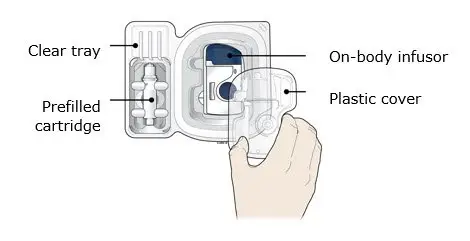 |
||
| Leave the on-body infusor and prefilled cartridge in the clear tray until you are ready to inject. | ||
|
||
| 1C | Gather all materials needed for your injection and then wash your hands well with soap and water. | |
| On a clean, well-lit work surface, place the: | ||
|
||
|
|
||
| 1D | To securely attach the on-body infusor, prepare and clean an injection site that is less likely to have body hair, or you can trim the area. Use a firm and flat skin surface. | |
You can use:
|  |
|
| Clean your injection site with an alcohol wipe. Let your skin dry. | ||
|
||
| Important: To attach the on-body infusor securely, it is important to use a firm and flat skin surface. | ||
| Step 2: Get ready | ||
| 2A | Open the on-body infusor by swinging the cartridge door to the right. Then, leave the door open. Do not close the cartridge door before the cartridge is loaded. | |
| If you accidently close the cartridge door, press on the left side of the door to release the door latch. If you are still unable to open the door, call 1-844-REPATHA (1-844-737-2842) or visit www.REPATHA.com. Do not press the start button until you are ready to inject. |
|
|
| 2B | Inspect the cartridge. | |
 |
||
| Check the expiration date: do not use if this date has passed. Make sure the medicine in the cartridge is clear and colorless to slightly yellow. |
||
|
||
| In any above cases, use a new on-body infusor and prefilled cartridge and call 1-844-REPATHA (1-844-737-2842) or visit www.REPATHA.com. | ||
| 2C | Clean the cartridge bottom. | |
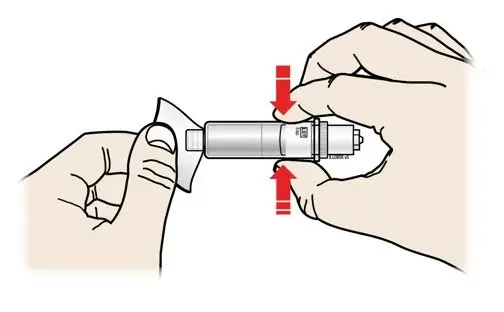 Grab Here Grab Here |
||
| With 1 hand, hold the cartridge barrel and clean the cartridge bottom with an alcohol wipe. | ||
|
||
| 2D | Load the cleaned cartridge into the on-body infusor and firmly press on the top until it is secured in place. Make sure that you give your injection within 5 minutes after loading the cartridge. Do not insert the cartridge more than 5 minutes before injection. This can dry out the medicine. | |
|
|
||
Insert the cartridge bottom first.
|
||
| 2E | Swing the door to the left. Then, squeeze firmly until it snaps shut. Apply enough pressure when closing the door and make sure there is a "snap" before going to the next step. | |
 |
||
| Make sure the cartridge fits securely in the on-body infusor before you close the door. | ||
|
||
| Step 3: Inject | |||
| 3A | Peel away both green pull tabs to show the adhesive. The on-body infusor is on when the blue status light flashes. | ||
 |
|||
You must remove both green pull tabs to turn the loaded on-body infusor on. You will hear beeping and see a flashing blue status light.
|
|||
| 3B | Choose your on-body infusor injection site. Only use the outer arm if someone else is giving the injection. | ||
| Stomach area placement | Thigh placement | ||
|
| or |
|
|
| Stretch method for stomach | Do not stretch for thigh | ||
| Important: Adjust your body posture to avoid skin folds and bulges. | |||
| 3C | When the blue light flashes, the on-body infusor is ready. Keep the stretch (stomach area method only). Hold the loaded on-body infusor with the blue light visible, and place it on your skin. You may hear beeps. | ||
| Stomach area placement | Thigh placement | ||
|
| or |
|
|
| The loaded on-body infusor will lay flat on your body. Make sure all of the adhesive is attached to your skin. Run a finger around the adhesive edges to secure it. | |||
| Make sure clothing does not get in the way of the loaded on-body infusor, and you can see the blue light at all times. | |||
|
|||
| 3D | Firmly press and release the start button. A flashing green light and a click signals the injection has started. | ||
|
|
|||
|
|||
| 3E | The injection takes about 5 minutes to finish. The status light turns solid green, and the device beeps, when done. | ||
|
|
|
||
| It is okay to hear a pumping sound start and stop during injection. |
|
||
Injection is finished when:
|
|
||
| Step 4: Finish | |||
| 4A | When the injection is done, grab the skin adhesive to carefully peel the on-body infusor off skin. After removal, check the medicine window. The green light should now be off. | ||
| Used plunger filling medicine window | |||
 |
|||
| Check to see that the used plunger fills the medicine window all the way, and the green solid light turns off, letting you know all medicine has been injected. If the plunger did not fill the window, call 1-844-REPATHA (1-844-737-2842) or visit www.REPATHA.com. | |||
|
|||
| 4B | Throw away the used on-body infusor in a sharps container. | ||
|  |
||
| 4C | Check the injection site. | ||
| If there is blood, press a cotton ball or gauze pad on your injection site. Do not rub the injection site. Apply an adhesive bandage if needed. | |||
| Troubleshooting | |||
| What do I do if the loaded on-body infusor status light continuously flashes red and I hear beeps? | |||
 |
|||
| Stop using the loaded on-body infusor. If the on-body infusor is attached to your body, carefully remove it. Call 1-844-REPATHA (1-844-737-2842) or visit www.REPATHA.com. | |||
| This Instructions for Use has been approved by the U.S. Food and Drug Administration. |
| Commonly Asked Questions |
| What if I hear the on-body infusor beep and see a red blinking light when it is on my body? |
| This means that an error has happened. When this happens, the injection will stop by itself. Remove the on-body infusor from your body by slowly and carefully peeling it off of your skin, call 1-844-REPATHA (1-844-737-2842) or visit www.REPATHA.com. |
| What should I do if the on-body infusor comes off my body during the injection? |
| Though unlikely, if the on-body infusor comes off during the injection, the on-body infusor will make a beeping sound, you will see the blinking red light, and the on-body infusor will stop. The loaded on-body infusor can no longer be used, and do not reapply to your body. Call 1-844-REPATHA (1-844-737-2842) or visit www.REPATHA.com. |
| What if I push the start button before I place the on-body infusor on my skin? |
| If you have removed the adhesive backing and pressed the start button, the on-body infusor will make a beeping sound and you will see the blinking red light. The on-body infusor will stop. Stop using the on-body infusor, call 1-844-REPATHA (1-844-737-2842) or visit www.REPATHA.com. |
| What if the on-body infusor does not beep and the blue status light does not blink when I remove the pull tabs? |
| Check to see if both green pull tabs have been fully removed from the on-body infusor, including the adhesive paper over the battery strip and needle cover. If both green pull tabs have been fully removed and the on-body infusor still does not turn on, use a new on-body infusor and prefilled cartridge. Call 1-844-REPATHA (1-844-737-2842) or visit www.REPATHA.com. |
| What if I push the start button and nothing happens? |
| Remove the on-body infusor by slowly and carefully peeling it away from your skin. Do not reapply the same on-body infusor that you have already placed on your skin. Call 1-844-REPATHA (1-844-737-2842) or visit www.REPATHA.com. |
| What if I cannot open the cartridge door to insert the cartridge? |
| To open the on-body infusor door, press on the left side of the door to release the door latch. If you are still unable to open the door, call 1-844-REPATHA (1-844-737-2842) or visit www.REPATHA.com. |
Manufactured by:
Amgen Inc.
One Amgen Center Drive
Thousand Oaks, CA 91320-1799
© 2015-2021 Amgen Inc.
All rights reserved.
<part number> Revised: 9/2021 v8
U.S. License Number 1080
| Additional environmental conditions
Relative humidity range is 15% to 85%. Altitude range is -984 feet to 11483 feet (-300 meters to 3500 meters). During injection, keep the on-body infusor a minimum of 12 inches (30 cm) away from other electronics such as cellular phones. Warning: Do not modify the device. Warning: Do not expose the on-body infusor for Repatha to Magnetic Resonance (MR) Environment (e.g., MRI). On-body infusor operating temperature range is 59°F to 104°F (15°C to 40°C). On-body infusor complies with IEC 60601-1 3.1 edition and IEC 60601-1-2: 2014. www.devicepatents.com. |
| SYMBOL TABLE | ||||
 |  |  |  |  |
| Do not re-use | Serial number | Type BF Applied Part | Do not use if packaging is damaged | On-Body Infusor containing 420 mg/3.5 mL (120 mg/mL) |
 |  |  |  |  |
| Sterilized using ethylene oxide | Refer to Instructions for Use | Lot number | Keep dry | Open here |
 | ||||
| MR Unsafe | ||||
Instructions for UseRepatha® (ri-PAth-a)(evolocumab)injection, for subcutaneous useSingle-Dose Prefilled SureClick® Autoinjector140 mg/mL
This Instructions for Use contains information on how to inject Repatha.
| Guide to parts |
| Before use | After use |
 |  |
| Important: Needle is inside the yellow safety guard | |
| Important |
Important Information You Need to Know Before Injecting Repatha:
|
| Step 1: Preparing to inject Repatha |
| 1A | Remove the autoinjector from the carton. | |
| Carefully lift the autoinjector straight up out of the carton. Before you inject, always check the label of the autoinjector to make sure you have the correct medicine and the correct dose of Repatha. Put the original carton with any unused autoinjectors back in the refrigerator. |
||
| Wait at least 30 minutes for the autoinjector to reach room temperature before injecting. |  |
|
| This is important for administering the entire dose and helps minimize discomfort. Repatha may take longer to inject if it has not reached room temperature. Do not heat the autoinjector. Let it come to room temperature naturally. | ||
|
||
| 1B | Inspect the Repatha SureClick autoinjector. | |
|
|
||
Make sure the medicine in the window is clear and colorless to slightly yellow.
|
||
| 1C | Gather all materials needed for your injection. | |
| Wash your hands thoroughly with soap and water. On a clean, well-lit work surface, place the:
|
||
|
|
|
|
| 1D | Prepare and clean your injection site. | |
| Only use these injection sites: | ||
|
||
 |
||
| Step 2: Get ready |
| 2A | Pull the orange cap straight off only when you are ready to inject. | |
| Do not leave the orange cap off for more than 5 minutes. This can dry out the medicine. | ||
 | 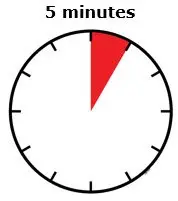 |
|
| Orange cap | ||
It is normal to see a drop of liquid at the end of the needle or yellow safety guard.
|
||
| 2B | Create a firm surface at the selected injection site (thigh, stomach, or outer areas of the upper arm), by using either the Stretch method or the Pinch method. | |
| Stretch method: | ||
 |
||
| Stretch the skin firmly by moving your thumb and fingers in opposite directions, creating an area about 2 inches wide. | ||
 |
||
| Pinch method: | ||
 |
||
| Pinch the skin firmly between your thumb and fingers, creating an area about 2 inches wide. | ||
| Important: Keep skin stretched or pinched while injecting. | ||
| Step 3: Inject |
| 3A | Keep holding the stretched or pinched skin. With the orange cap off, put the yellow safety guard on your skin at 90 degrees. The needle is inside the yellow safety guard. Do not touch the gray start button yet. | ||
|
|
|||
| 3B | Firmly push down the autoinjector onto the skin until it stops moving. | ||
 |
|||
| Important: You must push all the way down but do not touch the gray start button until you are ready to inject. | |||
| 3C | When you are ready to inject, press the gray start button. You will hear a click. | ||
 |
|||
| 3D | Keep pushing the autoinjector down on your skin. Then lift your thumb while still holding the autoinjector on your skin. Your injection could take about 15 seconds to complete. | ||
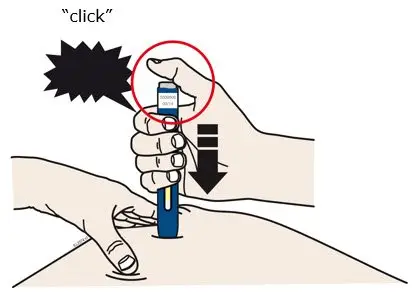 |  Window turns from clear to yellow when the injection is done. You may hear a second click. |
||
 | NOTE: After you remove the autoinjector from your skin, the needle will be automatically covered. | ||
| Important: When you remove the autoinjector, if the window has not turned yellow, or if it looks like the medicine is still injecting, this means you have not received a full dose. Call your healthcare provider immediately. | |||
| Step 4: Finish |
| 4A | Throw away the used autoinjector and orange needle cap. | |
| Put the used autoinjector and orange needle cap in an FDA-cleared sharps disposal container right away after use. Do not throw away (dispose of) the autoinjector or orange cap in your household trash. |
|
|
If you do not have an FDA-cleared sharps disposal container, you may use a household container that is:
|
||
| When your sharps disposal container is almost full, you will need to follow your community guidelines for the right way to dispose of your sharps disposal container. There may be state or local laws about how you should throw away used needles and syringes. For more information about safe sharps disposal, and for specific information about sharps disposal in the state that you live in, go to the FDA's website at: http://www.fda.gov/safesharpsdisposal. Do not dispose of your used sharps disposal container in your household trash unless your community guidelines permit this. Do not recycle your used sharps disposal container.
|
||
| Important: Always keep the sharps disposal container out of reach of children. | ||
| 4B | Check the injection site. | |
| If there is blood, press a cotton ball or gauze pad on your injection site. Apply an adhesive bandage if needed. Do not rub the injection site. |
||
| This Instructions for Use has been approved by the U.S. Food and Drug Administration. |
| Commonly Asked Questions |
| What will happen if I press the gray start button before I am ready to do the injection on my skin?
Even when you press the gray start button, the injection will only happen when the yellow safety guard is also pushed into the autoinjector. |
| Can I move the autoinjector around on my skin while I am choosing an injection site?
It is okay to move the autoinjector around on the injection site as long as you do not press the gray start button. However, if you press the gray start button and the yellow safety guard is pushed into the autoinjector, the injection will begin. |
| Can I release the gray start button after I start my injection?
You can release the gray start button, but continue to hold the autoinjector firmly against your skin during the injection. |
| Will the gray start button pop up after I release my thumb?
The gray start button may not pop up after you release your thumb if you held your thumb down during the injection. This is okay. |
| What do I do if I did not hear a second click?
If you did not hear a second click, you can confirm a complete injection by checking that the window has turned yellow. |
| Whom do I contact if I need help with the autoinjector or my injection?
A healthcare provider familiar with Repatha should be able to answer your questions. For more information, call 1-844-REPATHA (1-844-737-2842) or visit www.REPATHA.com. |
Manufactured by:
Amgen Inc.
One Amgen Center Drive
Thousand Oaks, CA 91320-1799
U.S. License No: 1080
© 2015-2022 Amgen Inc. All rights reserved.
<part number> Revised: 8/2022 v9
 This printed material is recyclable.
This printed material is recyclable.
| REPATHA
evolocumab injection, solution |
||||||||||||||||||||||||||||||
|
||||||||||||||||||||||||||||||
|
||||||||||||||||||||||||||||||
|
||||||||||||||||||||||||||||||
|
||||||||||||||||||||||||||||||
|
||||||||||||||||||||||||||||||
| REPATHA
evolocumab injection, solution |
||||||||||||||||||||
|
||||||||||||||||||||
|
||||||||||||||||||||
|
||||||||||||||||||||
|
||||||||||||||||||||
|
||||||||||||||||||||
| REPATHA
evolocumab kit |
||||||||||||||||||||
|
||||||||||||||||||||
|
||||||||||||||||||||
|
||||||||||||||||||||
|
||||||||||||||||||||
|
||||||||||||||||||||
|
||||||||||||||||||||
|
||||||||||||||||||||
|
||||||||||||||||||||
|
||||||||||||||||||||
|
||||||||||||||||||||
| Labeler - Amgen USA Inc. (962075045) |
| Registrant - Amgen, Inc (039976196) |








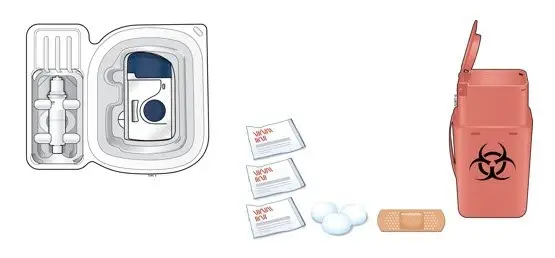















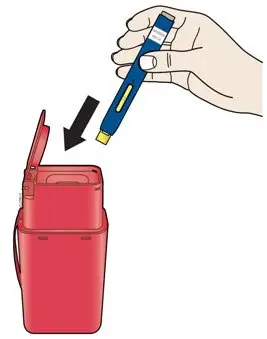



 This printed material is recyclable.
This printed material is recyclable. 